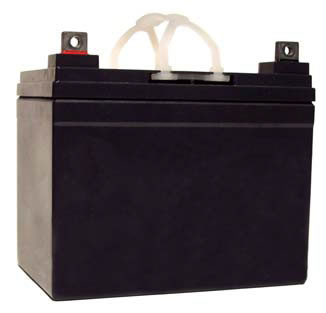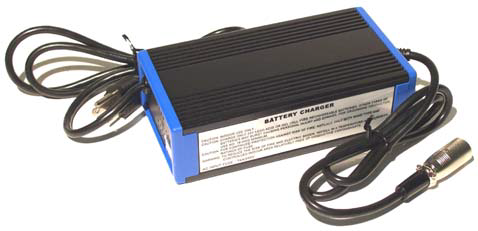Mobility Scooter Components
Batteries
Most scooters utilize 24-volt motors and electrical systems generally with two 12-volt batteries to power the drive train and controls.
These batteries are “deep cycle” batteries intended for wheelchairs and scooters and generally last between 12 and 18 months, although with conservation and regular charging, longer life may be achieved. Deep cycle batteries are designed to provide a steady supply of power and be discharged and recharged on a regular basis. Automotive and marine batteries, on the other hand, are designed to be starter batteries, providing short bursts of power only. Consequently, marine and automotive batteries should never be substituted for deep cycle batteries.
There are three basic types available for use with scooters: Lead acid (or wet cell) batteries, sealed lead-acid batteries, and gel cell batteries. Lead acid batteries are the least expensive of the three types, but they also require the most maintenance. In addition to regular charging, electrolyte and water levels must be checked regularly, with water added frequently to maintain appropriate levels. Because these batteries are not sealed, there is danger of acid spillage and explosion if the batteries are not handled properly.
Despite these potential problems, lead-acid batteries provide the benefits of a two-to six-month longer battery life and up to a ten percent greater running time than other battery types. Sealed lead acid batteries are maintenance-free versions of these batteries. Because they are sealed in cases, it is unnecessary to add water and the danger of acid spillage is reduced or eliminated. The cases are vented to prevent gas buildup that can lead to an explosion.
 A 12V x 36 AH (U1) battery
A 12V x 36 AH (U1) battery
Finally, gel cell batteries are the most commonly used battery type on scooters. They are sealed in their cases and require no maintenance other than regular charging.
Gel cells are the safest of the battery types, with no danger of spillage and limited risk of explosion. However, gel cells are more expensive and may have a somewhat shorter life than other battery types.
It should be noted that some manufacturers do not include the battery or batteries as part of the scooter; rather, they are considered extra-cost options.
The type and size of battery used on a given scooter should be selected in accordance with the recommendation of the manufacturer. It is particularly important that the battery be compatible with the battery charger to be used.
 A Spitfire EX 1420 travel scooter battery charger
A Spitfire EX 1420 travel scooter battery charger
Lead acid and gel cell batteries require different types of chargers operating at differing amperage levels, so their charges should never be used interchangeably. However, dual chargers capable of charging both types of batteries are also available. While the batteries are frequently optional, the charger is usually included with the scooter as part of the purchase price.
It may be an on-board internal charger built into the scooter’s base unit or it may be an external charger that is totally separate from the unit. On-board chargers have the benefit of allowing the user to recharge the batteries during an extended use, although it may be necessary to carry a separate cord or an extension cord to connect the unit to an electrical outlet. However, should an on-board charger require repair, it is necessary to take the entire scooter in for repair.
External chargers, on the other hand, require the user to carry extra equipment, but they also offer the benefit of easier repair or replacement, as well as the capability of charging the batteries away from the scooter, an option that can be particularly useful during travel because the batteries can be maintained without removing the scooter from the van or automobile.
